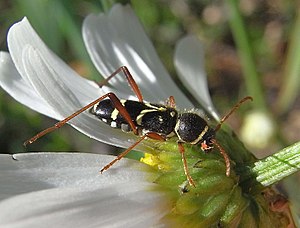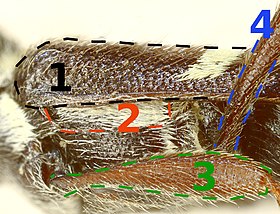Clytus rhamni
| Clytus rhamni | ||||||||||||
|---|---|---|---|---|---|---|---|---|---|---|---|---|

Clytus rhamni |
||||||||||||
| Systematics | ||||||||||||
|
||||||||||||
| Scientific name | ||||||||||||
| Clytus rhamni | ||||||||||||
| Germar , 1817 |

|
||
| Fig. 1: Upright hair on the pronotum and base of the wing cover | ||
 Photo: Fritz Geller-Grimm |

|

|
|
Fig. 2: Puncturing the pronotum (left, ♂) and the base of the wing cover (right) |
||

|
||
| Fig. 3: Top view drawing | Fig. 4: Sensor | |

|
Fig. 5: Side view, detail of outlines dashed 1 wing cover 2 episternum of the rear breast 3 thighs of the middle leg 4 hind legs |
|
Clytus rhamni occasionally, buckthorn Aries Bock called, is a beetle from the family of the longhorn beetle and the subfamily Cerambycinae. The genus Clytus is represented in Europe with seven species . In Central Europe, Clytus rhamni can easily be confused with other species of the same or even different genera.
In Bavaria the species is classified as critically endangered , in northern Germany it is extinct.
Note on names and synonyms
The species is described by Germar in 1817 under the name still valid today. Germar gives the beetle the species name rhamni because it occurs on the plant Rhamnus paliurus , the Christ thorn . The genus name Clytus goes back to Laicharting in 1784. Laicharting does not explain the name, after Schenkling it is from old Gr. κλυτός "klytós" derived for "famous, handsome" and originally stands for beautifully drawn longhorn beetles. Laicharting also lists the alpine buck as the first species in the genus .
Gautier des Cottes describes a particularly large and colorful variant from Corsica in 1862 as a separate species under the name Clytus bellieri , named after the collector Bellier, from whom he received the beetle. The name Callidium temesiense (temesiensis = occurring on the Temes river ) describes a beetle that differs from the southern European populations by yellow downy hair on its forehead and a slightly brownish black. The description remains unclear whether it comes from Germar himself or whether Germar publishes a description sent by Kollar . Bellieri and temesiensis are today classified by some authors as subspecies Clytus rhamni bellieri and Clytus rhamni temesiensis to the nominate form Clytus rhamni rhamni , considered by others as variants and accordingly listed as synonyms to Clytus rhamni .
Various authors the species was Clytus Gazella (lat. For Gazelle) called Fabricius describes under the name Clytus gazella but Clytus arietis .
Description of the beetle
With a length of six to twelve millimeters, Clytus rhamni is on average slightly smaller than the two other similar species found in Central Europe, the common ram ( Clytus arietis ) , which is common on hardwood, and the coniferous ram ( Clytus lama ). Like these, it is black with yellow to pale yellow markings made up of short, dense, close-fitting hairs (Fig. 1). In addition, it can be confused with species of the genera Xylotrechus and Chlorophorus . A good feature is the eye-catching sheen of the elytra .
The head is oriented downwards perpendicular to the body axis. In contrast to the genus Xylotrechus, it has no keels. The eleven-segment antennae thicken less at the end than in the clytus arietis and are brown throughout, at most very faintly at the end, not significantly darkened (Fig. 4). They are relatively short for longhorn beetles and do not reach half of the elytra.
The pronotum is slightly wider than the head and narrower than the elytra. It is widest in the middle and evenly rounded on the sides. It is less roughly punctured in the male than in the female. In this case, the points are separated from one another by slightly raised spaces, so that a network-like structure is created. The pronotum is more matt than the elytra, but more glossy than the pronotum of Clytus lama . It is hemmed in yellow at the rear edge, but the hem is usually interrupted in the middle. Usually the front edge is also more or less pale yellow. The entire pronotum and the base of the elytra are hairy protruding (Fig. 1).
The triangular label is also covered in dense yellow hair.
The elytra are not dense as in the other types of Clytus mentioned above, but only thinly dotted. Behind the base, the points are often further apart than the point diameter (Fig. 2 right). The elytra are about three times as long as together wide, widest at the shoulder and individually rounded at the end, not truncated. The drawing of the elytra (Fig. 3) consists of a teardrop-shaped blemish near the shoulder and three narrow bands in a cloudy yellow to strong yellow color. Typically, the shoulder patch runs diagonally inwards and backwards and becomes narrower in the process. However, it can also be absent. The foremost band is crescent-shaped and extends forward almost to the label. The middle one is turned slightly forward and the rear one limits the tip of the wing cover. The coniferous ram Clytus lama , Xylotrechus antilope and Xylotrechus arvicola also have an almost identical pattern on the wing covers .
The underside is black. The abdomen are separated from each other by yellowish white crossbars. Parts of the middle and rear breasts are also yellowish white due to the hairiness, in particular the episternum of the rear breast (Fig. 5 red no.2) is yellowish hairy almost over the entire length, in Clytus lama the hairiness is limited to the rear part of the episternum .
The strong, long legs are brown, only the thighs are usually darker. The fourth tarsal segment is reduced to the attachment of the fifth segment (pseudotetramer).
Clytus rhamni rhamni , Cl. rhamni temesiensis and Cl. rhamni bellieri differ only slightly in size, color and focus of distribution. In Turkey there is only Cl. rhamni temesiensis . A visual comparison of the three forms can be found on the Czech website of MEF Sláma.
biology
The species loves warmth and occurs in Central Europe in hot spots such as vineyards or southern slopes. The beetle can be found on wood (wooden stakes, stakes or sticks from oak and poplar and other types of hardwood), but more often on flowers of various types of plants ( buckthorn , dogwood , hawthorn , carrots and other umbellifers ). The species, which is rare in Central Europe, appears here from May to June. The larva develops in very dry dead wood of various shrubs and trees ( black locust , sweet chestnut , softwood , mastic shrub , Christ thorn , elm ). Unlike most longhorn beetles, the larva does not drill between the bark and the wood, but rather eats its way - at least in the case of stakes made of robinia wood - the shortest path into the wood, which it then bores straight through its length.
When observing the beetle regarding the problem of mimicry , it was found that the beetles are very shy. When approaching, they most often crawl into the inflorescences , or they drop, or they fly open.
distribution
The widespread species is reported in southern Europe from Portugal to Greece and radiates from the south to central Europe. To the east the species extends to the Crimea and the Caucasus , Armenia , Iraq , northern Iran and to the east of the Caspian Sea .
literature
- Heinz joy, Karl Wilhelm Harde, Gustav Adolf Lohse (ed.): The beetles of Central Europe . tape 9 . Cerambycidae Chrysomelidae . Spektrum Akademischer Verlag, Munich 1999, ISBN 3-8274-0683-8 , pp. 64 (first edition: Goecke & Evers, Krefeld 1966).
- Klaus Koch : The Beetles of Central Europe . Ed .: Heinz Freude . tape 3 : ecology . Goecke & Evers, Krefeld 1992, ISBN 3-87263-042-3 , pp. 34 .
- Adolf Horion: Faunistics of the Central European beetles. Volume 12: Cerambycidae - Longhorn Beetles. Überlingen - Bodensee 1974, p. 129.
Individual evidence
- ↑ a b Clytus rhamni at FE , accessed July 24, 2018
- ↑ Protection in Bavaria [1]
- ↑ Classification in Thuringia [2]
- ^ A b Germar : Journey to Dalmatia and in the area of Ragusa Leipzig and Altenburg 1817 p. 225 in the Google book search
- ^ A b Johann Nepomuk Laicharting: Directory and description of the Tyroler Insects 1st part, 2nd volume Zurich 1781 p. 104: 88 Clytus
- ^ Sigmund Schenkling: Nomenclator coleopterologicus 2nd edition, Jena 1922
- ↑ C. Gautier des Cottes: Genre nouveau de Staphilinien et déscription de nouvelles espèces de coléoptères de Syrie et d'Europe in Annales de la Société entomologique de France 4th series, 2nd volume, Paris 1862 p. 77. No. 4 Clytus Bellieri
- ↑ a b Sigmund Schenkling: Explanation of the scientific beetle names (species)
- ↑ Germar : Insectorum species - novae aut minus cognitae - descriptonibus illustratae Halle 1824 p. 519, No. 694 Callidium (Clytus) temesiense in the Google book search
- ↑ a b F. Picard: Faune de France - 20 - Coléoptères - Cerambycidae Paris 1929 key p. 100, synonyms p. 107
- ↑ Wissmann: Entomological Notes (continued) in Entomologische Zeitung 9th year, Stettin 1848 p. 78, X.
- ↑ Herrmann Schaum: Report on the achievements in entomology during the year 1848 in Archive for Natural History Volume 15, Volume 2, Berlin 1849 p. 172
- ↑ Edmund Reitter: About four coleopteras from the Palearctic fauna in Wiener entomologische Zeitung 23rd year Vienna 1904 p. 82 No. 3 Clytus rhamni v. nov. longicollis
- ↑ Determination table Clytus at coleo-net , accessed on July 24, 2018
- ↑ Mulsant : Tribe of Longicornes (suite) in Annales des sciences physiques et naturelles, d'agriculture et d'industrie Volume VII Lyon, Paris 1863 p.99 Clytus rhamni in the Google Book Search
- ↑ Ludwig Redtenbacher: Fauna Austriaca - Die Käfer 3rd edition, 2nd volume, Vienna 1874 key p. 408
- ↑ Hüseyin Özdikmen: Turkish Red List categories of Longicorn Beetles (Coleoptera: Cerambycidae) part VIII: subfamily Cerambycinae, Anaglyptini and Clytini. in Munis Entomology & Zoology Vol 9, No 2, June 2014: 687-712. PDF .
- ↑ Gallery with several photos each of the three subspecies in the middle area of the page ( memento of the original from August 1, 2018 in the Internet Archive ) Info: The archive link was automatically inserted and not yet checked. Please check the original and archive link according to the instructions and then remove this notice.
- ↑ Mulsant : Larves of Coléoptères in Annales de la Société de Lyon Linnéenne Volume 23 Lyon, Paris 1877 p.297 larva and pupa of Clytus rhamni in the Google Book Search
- ↑ AH Krausse: Clytus rhamni temesiensis Germ. and Clythanthus sartor F. Müll. - mimicry? in magazine for scientific insect biology Vol VI, Issue 8/9, Berlin-Schöneberg1910 p. 304
- ↑ Hüseyin Özdikmen, Mohammed Anwar Ali: Four genera and species new for the fauna of Iraque .... in Munis Entomology & Zoology Vol 12, No 2, June 2017 p. 377